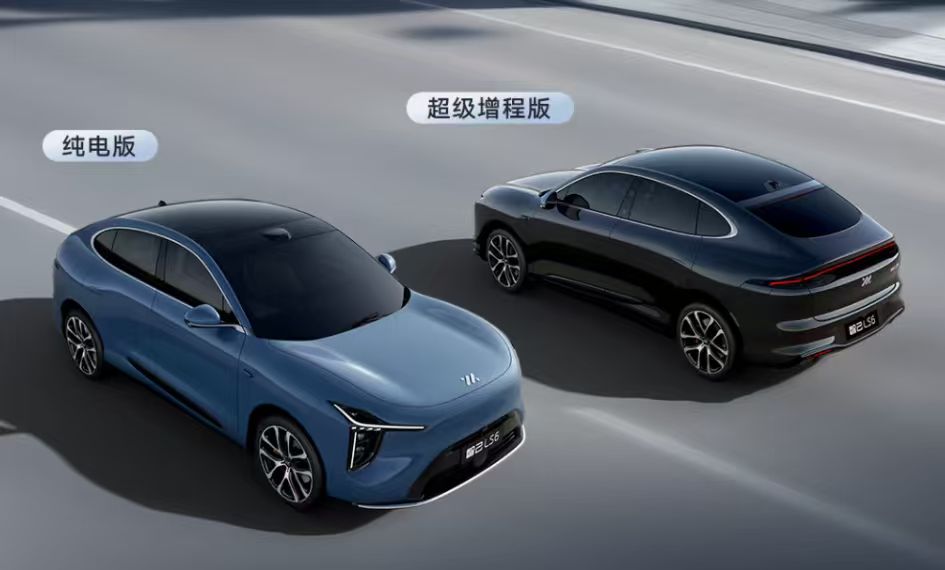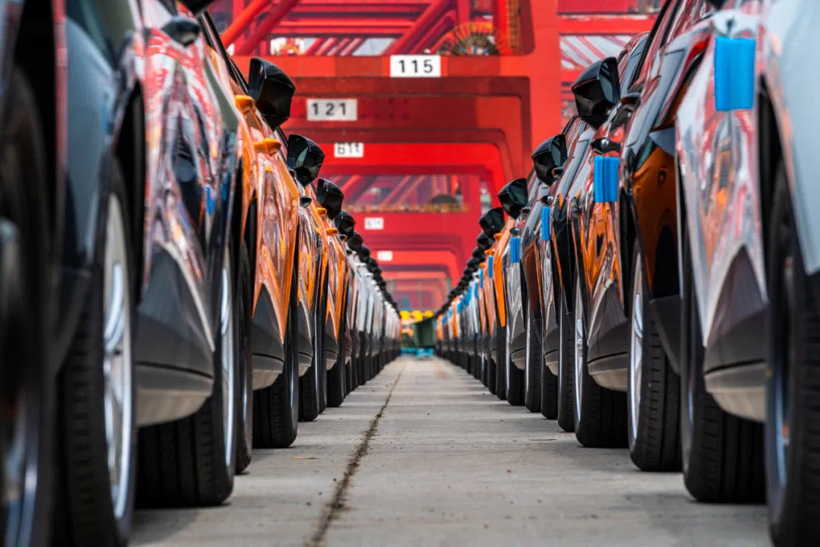Has SAIC Tasted the "Sweetness" of Transformation?
When the MG4 breaks the 70,000 yuan threshold for 400-kilometer pure electric A-class sedans with a starting price of 65,800 yuan, and when the Zhiji LS6 redefines the competitive landscape of the mid-to-high-end extended-range market with a price of 197,900 yuan, SAIC seems to be regaining its rhythm.
However, the popularity is just a facade. Behind these short-term victories, SAIC still has to face more severe challenges: Can high sales growth truly reverse the profitability dilemma? Can technological breakthroughs support the imagination of brand premiumization?
Ultimately, this transformation breakthrough is still a tough battle against time.

Image source: SAIC MG
Why have these two car models become bestsellers?
The market success of the MG4 and IM LS6 marks a shift in the competitive focus of the new energy vehicle market: it has transitioned from the early stage of competing on range and basic performance to a new phase centered on "technology equality" and "experience disruption." Although these two models target different price segments, they have both achieved phenomenal market breakthroughs by accurately understanding user needs and offering advanced technology configurations beyond their class.
The success of MG4 primarily stems from its highly impactful pricing strategy. The car is offered at a limited-time subsidized price of 65,800 to 99,800 yuan, bringing the 400-kilometer range version to under 70,000 yuan, while the 530-kilometer long-range version is priced under 90,000 yuan. Even the version equipped with a semi-solid-state battery is priced below 100,000 yuan.
This strategy not only significantly lowers the entry barrier for high-quality pure electric vehicles but also exerts strong pressure on competing products in the same class.
More importantly, the MG4 has achieved true "technological inclusivity," bringing several features that were previously only available in high-end models into the mainstream market.
Its greatest highlight is the world’s first mass adoption of semi-solid-state batteries in a production vehicle. This technology reduces the liquid electrolyte content to 5%, offering extremely high safety and enabling the battery to pass stringent 10-needle and three-direction penetration tests without smoking or catching fire.
As executives from SAIC have stated, consumers are attracted by "400km range under 70,000 yuan," "530km range for over 90,000 yuan," and "solid-state batteries under 100,000 yuan." This clearly demonstrates that tangible technological achievements combined with extremely competitive prices create a strong appeal.
In addition, the MG4 features CTB battery body integration technology, significantly enhancing body rigidity and interior space utilization. It also comes standard with a car-to-handset connectivity system based on the Qualcomm 8155 chip and OPPO's smart travel technology, achieving a seamless ecological experience across devices.
The MG brand recently announced its future product plan, which includes the launch of 13 new energy vehicles over the next three years, covering various powertrains such as pure electric, plug-in hybrid, and range-extended electric vehicles. Additionally, it will continue to deepen its collaboration with technology companies to build an intelligent ecosystem, further enhancing market expectations for its technological prospects.
Similarly, the success of the IM LS6 is also built on the combination of disruptive pricing and cutting-edge technology. As a mid-to-large SUV, its official starting price is set at 197,900 yuan, further lowering from the pre-sale price, giving it a clear price advantage when competing with models like the Model Y.
A major selling point of the IM LS6 is its technological breakthrough. Equipped with the "Stellar Super Range Extension" system, it achieves a pure electric range of 450 kilometers under the CLTC standard and a total comprehensive range of 1500 kilometers, surpassing many traditional fuel vehicles in performance.
At the same time, the 800V ultra-fast charging high-voltage platform supports charging for 15 minutes to replenish a range of 310 kilometers, greatly alleviating the pressure of energy replenishment.
In terms of intelligence, the entire LS6 series comes standard with the IM AD intelligent driving assistance system. Relying on a high-performance computing chip and a multi-sensor fusion system, it not only supports advanced functions such as urban navigation assistance but also innovatively introduces practical applications like "One-click AI Chauffeur," covering various scenarios such as parking in narrow spaces and driving on slippery roads. In terms of handling performance, the "Lingxi Digital Chassis" and rear-wheel active steering system effectively improve the maneuverability of large SUVs on narrow roads.
In summary, although the MG4 and Feifan LS6 are positioned in different price ranges and market segments, their success logic is highly consistent: focusing on genuine user needs, they have redefined the value standards of their respective markets through the large-scale application of advanced technology and highly impactful pricing.
The growing pains of transformation have not yet subsided, but the dawn is already visible.
As a giant in China’s automobile industry, SAIC Motor had long dominated domestic sales rankings through its joint venture business. However, amid the wave of transformation towards new energy vehicles, its transition has been fraught with challenges.
In recent years, there has been a significant gap between SAIC's strategic planning and actual performance in the new energy sector, exposing multiple issues such as dispersed resources, insufficient brand synergy, and lagging market-oriented progress.
SAIC's transition to new energy vehicles did not start late. As early as 2016, the group, in collaboration with Alibaba, launched the world's first internet car, the Roewe RX5, which once attracted significant attention from the industry. However, in the subsequent process, there were apparent deviations in strategy execution.
On one hand, the group has formed a pattern of multiple parallel development of new energy brands internally, especially with both Feifan and Zhiji focusing on the price range of 200,000 to 300,000 yuan, resulting in resource dispersion and internal competition. Feifan Automobile ultimately was incorporated into the Roewe system due to its market performance not meeting expectations. This process not only consumed a significant amount of funds and time but also missed the critical window for transformation.
On the other hand, the high-end brand Zhiji Automobile, which was highly anticipated, has failed to break into the market.
Despite its high positioning and advanced technical configuration, its sales have remained lackluster—only 5,000 units were sold in 2022. Although sales gradually increased to 38,000 and 66,000 units in 2023 and 2024 respectively, it failed to achieve its sales targets for two consecutive years. Compared with emerging brands during the same period, the gap is evident, reflecting systemic issues in product competitiveness, brand awareness, and user outreach.

Image source: Zhiji
In addition to challenges faced by its self-owned brands, SAIC’s long-relied-upon joint venture business is also entering a downward trajectory. SAIC Volkswagen and SAIC-GM, the two major joint ventures, contributed the majority of profits during the era of fuel vehicles, but have shown sluggish performance in the transition to electrification. Neither the Volkswagen ID. series nor Buick's electric products have been able to replicate the success they enjoyed in the era of fuel vehicles.
Sales of new energy vehicles in the joint venture sector remain sluggish, not only dragging down the group's overall new energy penetration rate but also causing a disruption in the profit structure. As the electrification process in the Chinese market accelerates, the halo effect of joint venture brands is gradually fading, and SAIC's profit pillar is beginning to waver.
In response to the challenging situation, SAIC has implemented a series of reforms since the management restructuring in 2023. The group has undertaken large-scale organizational and personnel adjustments, promoted a younger and more professional management team across its subsidiaries, and integrated resources to establish the "Large Passenger Vehicle Sector," aiming to focus resources on strengthening its self-owned business.
In terms of technology roadmap, we are actively investing in solid-state batteries and expanding cooperation with technology companies such as Huawei, Horizon Robotics, and OPPO.
Notably, the group has changed its previous stance of adhering to the "soul theory" and opted to collaborate deeply with Huawei to create a new brand, "Shangjie." The first model, Shangjie H5, is priced between 170,000 and 250,000 yuan, aiming to boost sales and address shortcomings in intelligent driving. This shift reflects SAIC's pragmatic attitude in seeking external support under real-world pressures.
In the first half of 2025, SAIC's reforms have initially shown some positive signs. The group's wholesale vehicle sales increased by 12.4% year-on-year, reaching 2.053 million units; new energy vehicle sales totaled 646,000 units, up 40.2% year-on-year, with new energy vehicle sales in August alone increasing by 49.89% year-on-year. Revenue reached 299.588 billion yuan, up 5.23% year-on-year, reversing the decline seen in the same period of 2024.
However, this "mixed" report card still reveals deep-seated issues: revenue growth lags far behind sales growth, with the average price per vehicle dropping from 155,800 yuan to 145,900 yuan, highlighting the helplessness of "discounting to boost sales"; net profit attributable to shareholders declined by 9.21% year-on-year, marking a setback for two and a half consecutive quarters, and the net profit scale is less than half of that in the same period of 2021. In addition, IM Motors recorded a net loss of 1.825 billion yuan in the first half of the year, becoming a financial burden for the group.
In summary, SAIC Motor’s transition to new energy has experienced significant setbacks and deep reflection. With deeper internal integration and a greater focus on independent operations and technological R&D, the company has recently shown signs of recovery. Going forward, SAIC still needs to further clarify its brand hierarchy, optimize supply chain costs, and strengthen its technological image in order to secure a firm foothold in the upcoming industry reshuffle.
Three years to sharpen a sword.
SAIC Motor's three-year strategic transformation has begun to show results. Despite facing numerous challenges and fluctuations, the ongoing investment is gradually translating into tangible market returns and improvements in system capabilities.
In terms of technological research and development, SAIC adheres to independent research and development of core technologies. In recent years, nearly 60% of its R&D funding has been invested in the field of new energy vehicles, gradually constructing a systematic platform capability represented by the "Seven Major Technology Foundations 2.0," including the Nebula pure electric exclusive platform, the Everest electromechanical integration architecture, and the Galaxy hydrogen-electric integration architecture. These underlying technology platforms provide a solid foundation for the company to quickly respond to market demands and launch a diverse range of products.
Meanwhile, SAIC has achieved significant breakthroughs in several key technological fields: the development of solid-state batteries continues to progress, the 800V high-voltage platform has been successfully implemented, and the self-developed dual-silicon carbide "quasi-900V" electric drive system has also entered mass production. These accomplishments fully demonstrate the Group's determination and efficiency in deep innovation in electrification.
To efficiently advance its strategy, SAIC has implemented a series of significant changes at the organizational and institutional levels. The Group has established a "Three-Year Action Command Center" to streamline management layers and accelerate decision-making processes. Measures such as signing performance pledges, implementing incremental incentives, and setting up a 100-million-yuan "seed fund" have been adopted to stimulate team motivation for tackling challenges and fostering innovation. In terms of supply chain collaboration, an integrated "production-sales-logistics" platform has been built, greatly shortening the development cycle of vehicle projects.
Globalization has become a key driver of SAIC’s growth. The group has initially established an international network covering R&D, manufacturing, sales, and services, including four overseas vehicle manufacturing bases, over 100 parts production and R&D facilities, as well as more than 2,800 marketing and service outlets.
In Thailand, the base achieved localized mass production of new energy batteries and pure electric vehicles. The success of the MG4 EV in overseas markets is attributed to the flexible model of "Chinese R&D, local production."

Image source: SAIC
From January to August 2025, SAIC Motor's overseas sales reached 664,000 units, a year-on-year increase of 2.3%. The MG brand entered the top ten in sales in more than 20 European countries, proving the effectiveness of the "global R&D + localized operation" model. Currently, SAIC has established three major innovation R&D centers in London, Silicon Valley, and Tel Aviv, continuously integrating global technology and talent resources.
SAIC is also actively promoting open cooperation and building an innovation ecosystem. The ZhiJie H5, developed in collaboration with Huawei, received 50,000 orders within 18 hours of pre-sale, demonstrating strong market appeal. In the field of intelligent assisted driving, SAIC is collaborating with multiple parties, including Momenta, DJI, Huawei, and Horizon, to avoid single dependency and maintain strategic flexibility. In terms of smart cockpits, SAIC has partnered with OPPO to launch the "Eco-Domain" concept, promoting an upgraded cross-terminal interconnectivity experience.
Faced with new markets and user demands, SAIC is actively promoting the transformation of its marketing system and user operations. The addition of a group of young managers has infused the team with user-centric thinking that is more in tune with the market. Digital methods such as live-stream e-commerce and social marketing have been widely implemented, becoming new platforms for brand communication. The company also encourages technical experts and product managers to communicate directly with users, enabling more agile capture of consumption trends and response to feedback.
Over the course of three years of transformation, although SAIC still faces challenges such as industry price competition and uncertainty in technological routes, it has gradually clarified a development path aligned with its own conditions in electrification, intelligence, and internationalization through practical experience during this period.
The market performance of the MG4 and IM LS6 serves as an important window to observe SAIC New Energy's transformation. It not only demonstrates the explosive power brought by the combination of technological breakthroughs and pricing strategies but also highlights the deep challenges faced by traditional automakers: how to balance sales and profitability, how to integrate internal resources, and how to rebuild independent competitiveness amid the contraction of joint venture businesses.
【Copyright and Disclaimer】The above information is collected and organized by PlastMatch. The copyright belongs to the original author. This article is reprinted for the purpose of providing more information, and it does not imply that PlastMatch endorses the views expressed in the article or guarantees its accuracy. If there are any errors in the source attribution or if your legitimate rights have been infringed, please contact us, and we will promptly correct or remove the content. If other media, websites, or individuals use the aforementioned content, they must clearly indicate the original source and origin of the work and assume legal responsibility on their own.
Most Popular
-

List Released! Mexico Announces 50% Tariff On 1,371 China Product Categories
-

EU Changes ELV Regulation Again: Recycled Plastic Content Dispute and Exclusion of Bio-Based Plastics
-

Mexico officially imposes tariffs on 1,400 chinese products, with rates up to 50%
-

Clariant Unveils Cost-Cutting Plan Details, Plans to Shut Down Multiple Plants
-

Nissan Cuts Production of New Leaf EV in Half Due to Battery Shortage






